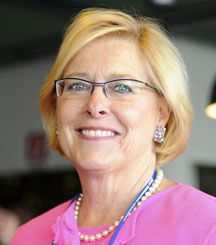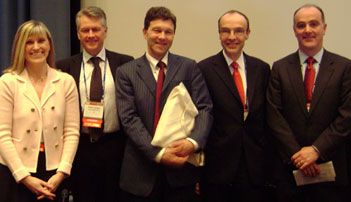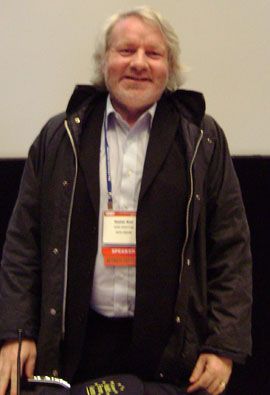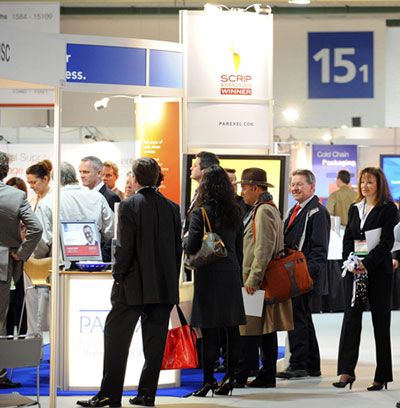March Memories from Berlin
A look back at DIA's 2009 EuroMeeting.
It might be 20 years younger than its U.S. counterpart, but DIA’s 21st Annual EuroMeeting proved to be a mature gathering of over 3500 professionals from over 50 countries. And for the second time since 1994, the city of Berlin played host to the three-day event, which ran from March 23-25.

Outside the spaceship-like Internationales Congress Centrum where inside hustle and bustle was the norm, Germany’s capital city celebrated with no noticeable fanfare the 20th anniversary of the Berlin Wall’s collapse. A fact brought to the attention of the audience that gathered for the plenary that officially kicked off the beginning of the meeting.
Inside the packed auditorium, DIA’s president of the Board of Directors Marie Dray-president of Dray Regulatory Associates-reflected on the similarity between the historic event and the 45-year-old association. What both share in common, she said, is the theme of unification. “DIA’s members have long understood the value of working together,” she said. “Berlin’s successful unification is a good example of DIA, of redefining itself.”
And it will continue to, according to Dray. She explained that the meetings of tomorrow will look nothing like the DIA meetings of today. With the exception of the U.S. and European annual meetings and those in areas with a growing DIA presence like China, India, Latin and South America, Africa, and the Middle East, a large portion of activities, including training and education, will move online.
”It’s really not DIA making that decision,” explained William Brassington, acting DIA worldwide executive director, “it’s what the market wants from us.”
The want is influenced by the global nature of industry today-reflected by the fact that for the first time in its history DIA’s two candidates for president live outside the United States-and by the current economic environment. Just as financial pressures are changing the face of R&D, they are also at the forefront of change at DIA.

“DIA is facing economic pressures it has never faced,” said Dray, “We will focus on our legacy as a neutral forum as we reexamine methods to bring members together."
Down to business
A not necessarily “new” but better way of operating was the focus of this year’s plenary. During the three hour debate-which was pleasantly interrupted with a performance by the Berlin Children’s Choir-moderators probed the minds of the eight member panel with questions on topics such as the state of the European Regulatory Agency, transparency, generics, and the impact of drugs on the environment.
Regulatory beat. Thomas Lonngren, EMEA's executive director, summed up the walk-away message when he told the audience: “We have a robust system for 14 years. I don’t think we should change it in a major way, [but] fine tune it.”
According to Lonngren, one area that needs fine-tuning is clinical trials. A more centralized approach to them, he said, would benefit the EU and also make it more competitive.
But as for any talk of moving toward a single, centralized regulatory agency like the U.S. FDA, Lonngren made it clear that is not the desired outcome of the EU, whose success, he told the audience, has nothing to do with a centralized system. "It doesn't work that way," he said, "You build on what you've already achieved."
Moving forward, other areas where he'd like to see improvements made include transparency and science. In the science arena, Lonngren expressed satisfaction with the Committee on Advanced Therapies (CAT), but acknowledged the EU's need to increase its capacity to work with others to meet today's scientific challenges.
What seemed like refreshing insight came from panelist Christine Akerman, director general, medical products agency, Sweden. Her suggestions for a better governance system [the plenary's theme] included: increase work sharing among the European Network of experts; better collaboration between the national authorities and EMEA [a sentiment echoed]; and reduce travel by replacing one-third of it with virtual video meetings, which would provide an opportunity for all member states to attend and share in.
Akerman did acknowledge the importance of continued face-to-face meetings among EU experts and stressed the need "to develop a system where

scientific assessment of new drugs will not be repeated." Her idea: Start a pilot project whereby agencies offer joint scientific advice to prevent or lessen repeat work.
Generic report. Generics seem to be a hot topic in the EU. Pricing and reimbursement was brought up, with consensus that member states stay responsible for final decisions but that the Commission could play a role as a "coordinator" to improve communication among member states and help set ideas into motion.
"We can be quite an important player in this area," announced Martin Terberger, head of unit, European Commission, and Enterprise and Industry DG Pharmaceutical Unit, EU.
Criticism came by way of Georg Stark, joint managing director at Alfred E. Tiefenbacher, an API business that provides generic pipeline services. In addition to speaking of the need for a generic pricing policy, with pricing automatically given upon market authorization, he complained that "regulations are blocking generic products and are giving access to early generic products away."
As for what's at the heart of the generics debate in the EU, Alastair Kent, director of genetic interest group and president of EGAN, shed some light. "We need to strike a balance," he said, "between access to generics and sustainability of programs to develop innovative medicines." One got the feeling a verbal game of chicken or the egg was taking place on stage between the pharma and generic industries, with Stark declaring: "There will be no innovative medicines without generics being available."

Nonetheless, generic talk wrapped up with audience laughter over the friendly banter between both sides: Stark on the one and Eddie Gray, president pharmaceuticals Europe for GSK, on the other.
A greener pharma. The question was posed: Will environmental requirements decrease the availability of new medications? It did for the veterinary industry, said Lonngren, who explained it made it tougher for that group to get approvals. "I think it's extremely important we know more about it," he said, indicating a need for further research on the impact of drugs on the environment.
This was the one topic that nearly all panelists addressed. Their thoughts on the issue:
• "It's about how to meet the needs of the present generation without jeopardizing future."-Akerman
• "I guess [the] challenge is one of scientific demonstration and proportionality."-Gray
• "We could learn lessons from veterinary, especially for proportionality, there is some example already."-Terberger
• "It shouldn't, but I suspect what will happen is interpretation [in direct response to the question if eco requirements will decrease new drug availability]."-Kent
• "Maybe price of products will go up."-Floortje van Nooten, senior research associate, UBS, Belgium
• “Should look at [a] more global scale."-Stark
The directive. What's a European meeting without talk of the directive? It's still got a reputation for "driving clinical trials out of the EU and academic research," said Terberger. "We'll look at this and bring life to criticism, and if necessary we'll make legal proposals."
One panelist who brought to life some of his own criticism was Kent, who blamed the directive for the increased regulatory burden in academia. His vision for an improved research arena involves patients, who would help determine trial risk and end points. "Patients are not content that decisions are made by others," he said. "Patients want to see a more flexible approach by regulators."
On a positive note, Akerman let it be known that harmonization of the directive is a priority for member states. She again suggested video and Web-based meetings, expressing an optimistic cup-is-half-full view. "I see room in clinical trials directive for harmonization," she said, "and no need for a new one."
Continental spread
Keeping in line with the global theme of the meeting was the down-to-earth session on conducting international trials. What made it so were the speakers, who didn't glamorize what it's like to undertake studies in emerging areas like China, India, and Latin America.
They covered the good and the not so good. But also made it perfectly clear that these trials need to be done and that there's no turning back. Already, participation by these regions in clinical trials has increased dramatically over the past three years-as much as 74.5% in China, 27.4% in India, and 30.7% in Latin America [with the largest market in Brazil], according to figures presented.
As for what's driving this globalization, Graciela Racaro, senior director of Latin American operations at Parexel, credits:
• FDA's acceptance of foreign data
• Faster enrollment rates because of global outreach
• Cost reductions due to lower salaries [but the one-time huge gap for investigator grants is closing up]
• Market potential for Brazil, Russia, India, and China, or BRIC.

Her key message: "Think globally but execute locally."
Even then though, expect challenges. Which is what Per Nilsson, head of strategic clinical development, and his colleagues at Switzerland-based Actelion Pharmaceuticals found themselves up against after launching trials in China and India.
Nilsson described the experience as “maze-like,” revealing that it took about two years for the Chinese study to officially get underway. One reason for the delay: Eventually-and not right away-a large portion of the intended study population was deemed “off limits” by regulators because they were of childbearing age. Nilsson indicated that such a decision would not have been sprung on the sponsor like that in the United States or Europe.
Meanwhile in India, during the course of the study two sites that had been recognized as credible by the company early on were eventually closed by authorities without an explanation.
As for advice when undertaking studies in developing countries:
• Do not rely on email and fax for initial communication with investigators. The best way to get an understanding of their capabilities and limitations is in a telephone conversation.
• Consider the standard of care in the country because it might be different than what you’re used to. For the best insight, check with key opinion leaders in the region before making a decision.
• Arm yourself with as much information as you can by conducting a feasibility study.
“Make your decisions based on data and experience,” advised Racaro.” Amen.
Behind the Buzz: Why Clinical Research Leaders Flock to SCOPE Summit
February 7th 2025In this episode, we meet with Micah Lieberman, Executive Conference Director for SCOPE Summit (Summit for Clinical Ops Executives) at Cambridge Innovation Institute. We will dive deep into the critical role of collaboration within the clinical research ecosystem. How do we bring together diverse stakeholders—sponsors, CROs, clinical trial tech innovators, suppliers, patients, sites, advocacy organizations, investors, and non-profits—to share best practices in trial design, program planning, innovation, and clinical operations? We’ll explore why it’s vital for thought leaders to step beyond their own organizations and learn from others, exchanging ideas that drive advancements in clinical research. Additionally, we’ll discuss the pivotal role of scientific conferences like SCOPE Summit in fostering these essential connections and collaborations, helping shape the future of clinical trials. Join us as we uncover how collective wisdom and cross-industry partnerships are transforming the landscape of clinical research.
Reaching Diverse Patient Populations With Personalized Treatment Methods
January 20th 2025Daejin Abidoye, head of solid tumors, oncology development, AbbVie, discusses a number of topics around diversity in clinical research including industry’s greatest challenges in reaching diverse patient populations, personalized treatment methods, recruitment strategies, and more.
Phase III Trial Data Show Subcutaneous Pembrolizumab as Noninferior to IV Keytruda
March 31st 2025Subcutaneous administration of pembrolizumab with chemotherapy demonstrated a nearly 50% reduction in patient chair and treatment room time while maintaining efficacy and safety endpoints compared to intravenous Keytruda.
Phase II ALPACA Trial Shows Lepodisiran Produces Significant, Sustained Lipoprotein(a) Reductions
March 31st 2025Eli Lilly’s lepodisiran, an investigational siRNA therapy, achieved significant and durable reductions in lipoprotein(a) levels, a major genetic risk factor for cardiovascular disease.